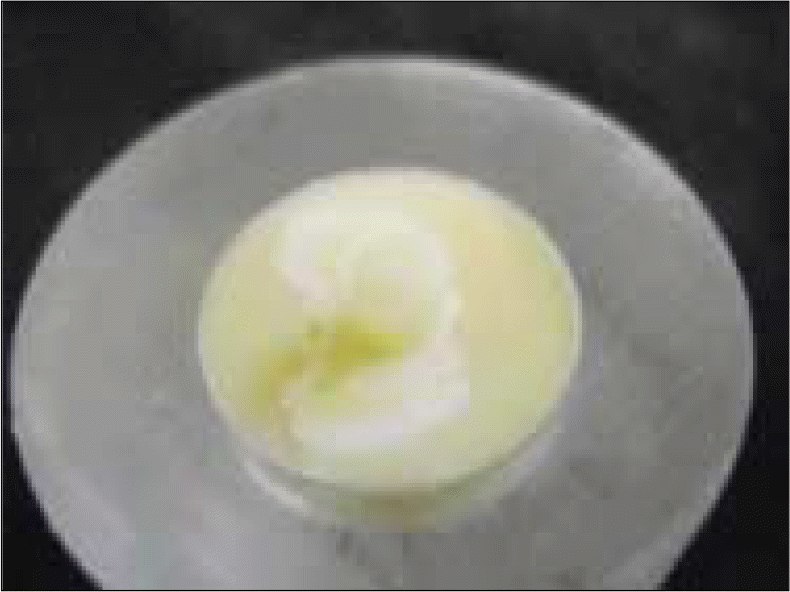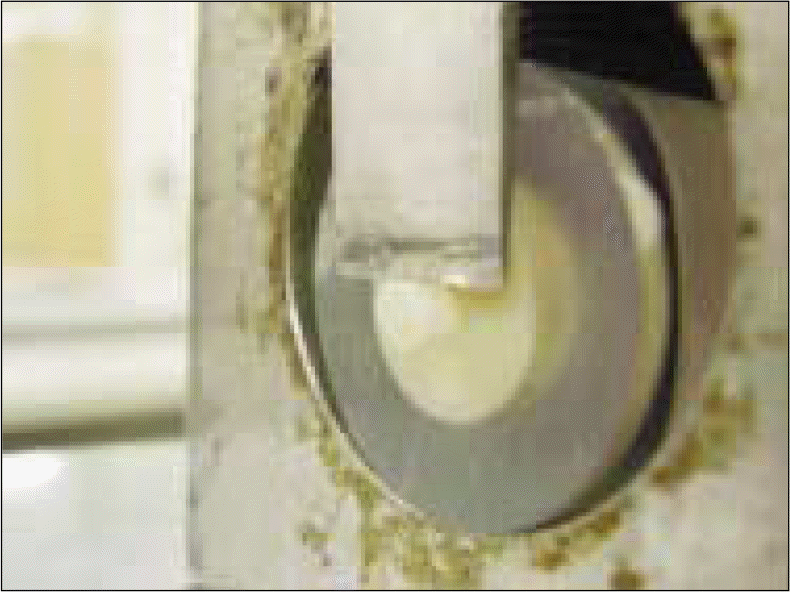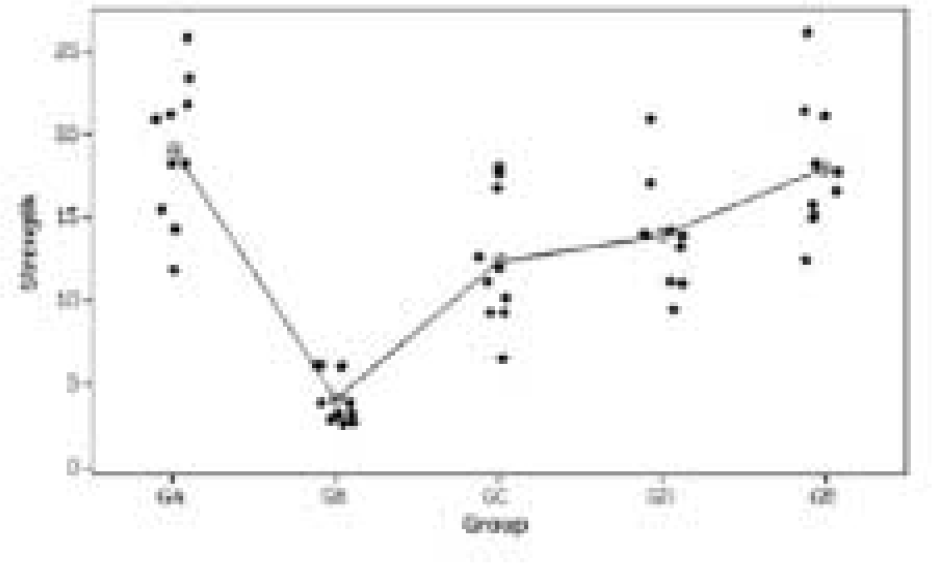Abstract
Statement of problem
There is a reduction of dentin bonding strength when the bonding procedure is carried out immediately after bleaching with peroxides.
Purpose
The aim of this study is to evaluate a proper time interval for in-office bleaching technique using 35% hydrogen peroxide.
Material and methods
Fifty extracted non-caries human third molars were used in this study. Buccal enamel of each tooth was removed and polished by 600 grits silicone carbide paper. They were randomly divided into five groups and bleached 35% hydrogen peroxide except control group. All groups were bonded with Single Bond/Z 350 after each time intervals; Group-A: control, no bleaching treatment. Group-B: resin bonding immediately after bleaching. Group-C: resin bonding 1day after bleaching. Group-D: resin bonding 2 days after bleaching. Group-E: resin bonding 7days after bleaching. Shear bond strengths were measured with a cross-head speed of 1.0 mm/min using an Instron machine. The data of results were statistically analyzed by analysis of variance (ANOVA) and Tukey multiple comparison test. (P = .05)
Results
There were significant decreases in mean shear strength in immediately bonding group after bleaching. The reduction of bond strengths was 78% compared with the group of no bleaching treatment. Group C showed the recovery of 51%, and Group D showed recovery of 63%. Both of them have no statistical difference with non-bleaching group. Group E showed no statistical difference with no bleaching treatment group.
Conclusion
Dentin bonding strength is significantly reduced when bonding is performed immediately after bleaching for in-office bleaching regimens using 35% hydrogen peroxide, and increases as time goes by. One week of elapsed time between bleaching and resin bonding significantly increases bonding strengths for the in-office bleaching technique.
Go to : 
REFERENCES
1.Camargo SE., Valera MC., Camargo CH., Gasparoto Mancini MN., Menezes MM. Penetration of 38% hydrogen peroxide into the pulp chamber in bovine and human teeth submitted to office bleach technique. J Endod. 2007. 33:1074–7.

2.Haywood VB. History, safety, and effectiveness of current bleaching techniques and applications of the nightguard vital bleaching technique. Quintessence Int. 1992. 23:471–88.
3.Sasaki RT., Barbosa MC., Flo ′rio FM., Basting RT. Enamel microhardness and shear bond strength after treatment with an 18% carbamide peroxide bleaching varnish. Am J Dent. 2007. 20:324–8.
4.Basting RT., Rodrigues AL Jr., Serra MC. The effects of seven carbamide peroxide bleaching agents on enamel microhardness over time. J Am Dent Assoc. 2003. 134:1335–42.

5.Lewinstein I., Fuhrer N., Churaru N., Cardash H. Effect of different peroxide bleaching regimens and subsequent fluoridation on the hardness of human enamel and dentin. J Prosthet Dent. 2004. 92:337–42.

6.Taher NM. The effect of bleaching agents on the surface hardness of tooth colored restorative materials. J Contemp Dent Pract. 2005. 15(6):18–26.

7.Benetti AR., Valera MC., Mancini MN., Miranda CB., Balducci I. In vitro penetration of bleaching agents into the pulp chamber. Int Endod J. 2004. 37:120–4.
8.Heller D., Skriber J., Lin LM. Effect of intracoronal bleaching on external cervical root resorption. J Endod. 1992. 18:145–8.

9.Amato M., Scaravilli MS., Farella M., Riccitiello F. Bleaching teeth treated endodontically: long-term evaluation of a case series. J Endod. 2006. 32:376–8.

10.Shinohara MS., Peris AR., Pimenta LA., Ambrosano GM. Shear bond strength evaluation of composite resin on enamel and dentin after nonvital bleaching. J Esthet Restor Dent. 2005. 17:22–9.

11.Titley KC., Torneck CD., Smith DC., Adibfar A. Adhesion of composite resin to bleached and unbleached bovine enamel. J Dent Res. 1988. 67:1523–8.

12.Titley KC., Torneck CD., Ruse ND. The effect of carbamide-peroxide gel on the shear bond strength of a micro-fil resin to bovine enamel. J Dent Res. 1992. 71:20–4.

13.Torneck CD., Titley KC., Smith DC., Adibfar A. The influence of time of hydrogen peroxide exposure on the adhesion of composite resin to bleached bovine enamel. J Endod. 1990. 16:123–8.

14.McGuckin RS., Thurmond BA., Osovitz S. Enamel shear bond strengths after vital bleaching. Am J Dent. 1992. 5:216–22.
15.Lai SC., Tay FR., Cheung GS., Mak YF., Carvalho RM., Wei SH., Toledano M., Osorio R., Pashley DH. Reversal of compromised bonding in bleached enamel. J Dent Res. 2002. 81:477–81.

16.Vongphan N., Senawongse P., Somsiri W., Harnirattisai C. Effects of sodium ascorbate on microtensile bond strength of total-etching adhesive system to NaOCl treated dentine. J Dent 2005. 2005. 33:689–95.

17.Muraguchi K., Shigenobu S., Suzuki S., Tanaka T. Improvement of bonding to bleached bovine tooth surfaces by ascorbic acid treatment. Dent Mater J. 2007. 26:875–81.

18.Bulut H., Turkun M., Kaya AD. Effect of an antioxidizing agent on the shear bond strength of brackets bonded to bleached human enamel. Am J Orthod Dentofacial Orthop. 2006. 129:266–72.

19.Dishman MV., Covey DA., Baughan LW. The effects of peroxide bleaching on composite to enamel bond strength. Dent Mater. 1994. 10:33–6.

20.Spyrides GM., Perdiga ̃o J., Pagani C., Arau ′jo MA., Spyrides SM. Effect of whitening agents on dentin bonding. J Esthet Dent. 2000. 12:264–70.

21.Cavalli V., Reis AF., Giannini M., Ambrosano GM. The effect of elapsed time following bleaching on enamel bond strength of resin composite. Oper Dent. 2001. 26:597–602.
22.Sundfeld RH., Briso AL., De Sa ′PM., Sundfeld ML., Bedran-Russo AK. Effect of time interval between bleaching and bonding on tag formation. Bull Tokyo Dent Coll. 2005. 46:1–6.

23.Sulieman M., MacDonald E., Rees JS., Newcombe RG., Addy M. Tooth bleaching by different concentrations of carbamide peroxide and hydrogen peroxide whitening strips: an in vitro study J Esthet Restor Dent. 2006. 18:93–101.
24.Al-Salehi SK., Wood DJ., Hatton PV. The effect of 24h nonstop hydrogen peroxide concentration on bovine enamel and dentine mineral content and microhardness. J Dent. 2007. 35:845–50.

25.Elkhatib H., Nakajima M., Hiraishi N., Kitasako Y., Tagami J., Nomura S. Surface pH and bond strength of a self-etching primer/adhesive system to intracoronal dentin after application of hydrogen peroxide bleach with sodium perborate. Oper Dent. 2003. 28:591–7.
26.Leonard RH Jr., Garland GE., Eagle JC., Caplan DJ. Safety issues when using a 16% carbamide peroxide whitening solution. J Esthet Restor Dent. 2002. 14:358–67.

27.Jiang T., Ma X., Wang Y., Zhu Z., Tong H., Hu J. Effects of hydrogen peroxide on human dentin structure J Dent Res. 2007. 86:1040–5.
28.Bishara SE., Oonsombat C., Soliman MM., Ajlouni R., Laffoon JF. The effect of tooth bleaching on the shear bond strength of orthodontic brackets. Am J Orthod Dentofacial Orthop. 2005. 128:755–60.

29.Toko T., Hisamitsu H. Shear bond strength of composite resin to unbleached and bleached human dentine. Asian J Aesthet Dent. 1993. 1:33–6.
30.Basting RT., Rodrigues JA., Serra MC., Pimenta LA. Shear bond strength of enamel treated with seven carbamide peroxide bleaching agents. J Esthet Restor Dent. 2004. 16:250–60.

Go to : 
 | Fig. 1.Specimen after composite resin bonding (Resin block was carefully bonded to dentin only). |
 | Fig. 2.Specimen in Instron machine (Bonding failure were conformed to measure shear bond strength between resin block and dentin). |
 | Fig. 3.Individual and mean value of shear bond strength (GA-Group A, GB-Group, GC-Group C, GD-Group D, GE-Group E). |
Table I.
Materials used in this study
Table II.
Mean value and Standard deviation of shear bond strength
Table III.
Results of ANOVA for shear bond strengths
| Sum of squares | df | Mean square | F value | P value | |
|---|---|---|---|---|---|
| Between groups | 1207.972 | 4 | 301.993 | 31.544 | .000 (∗) |
| Within groups | 430.813 | 45 | 9.574 | ||
| Total | 1638.785 | 49 |
Table IV.
Results of Tukey Multiple comparisons for shear bond strengths
| Group | Comparison | n Mean Difference | Standard error | P value |
|---|---|---|---|---|
| A | B | 13.7500 | 1.3837 | 0.000 (∗) |
| C | 6.6500 | 1.3837 | 0.000 (∗) | |
| D | 5.1100 | 1.3837 | 0.005 (∗) | |
| E | 0.8900 | 1.3837 | 0.967 | |
| B | A | -13.7500 | 1.3837 | 0.000 (∗) |
| C | -7.1000 | 1.3837 | 0.000 (∗) | |
| D | -8.6400 | 1.3837 | 0.000 (∗) | |
| E | -12.8600 | 1.3837 | 0.000 (∗) | |
| C | A | -6.6500 | 1.3837 | 0.000 (∗) |
| B | 7.1000 | 1.3837 | 0.000 (∗) | |
| D | -1.5400 | 1.3837 | 0.799 | |
| E | -5.7600 | 1.3837 | 0.001 (∗) | |
| D | A | -5.1100 | 1.3837 | 0.005 (∗) |
| B | 8.6400 | 1.3837 | 0.000 (∗) | |
| C | 1.5400 | 1.3837 | 0.799 | |
| E | -4.2200 | 1.3837 | 0.030(∗) | |
| E | A | - .8900 | 1.3837 | 0.967 |
| B | 12.8600 | 1.3837 | 0.000 (∗) | |
| C | 5.7600 | 1.3837 | 0.001 (∗) | |
| D | 4.2200 | 1.3837 | 0.030 (∗) |




 PDF
PDF ePub
ePub Citation
Citation Print
Print


 XML Download
XML Download